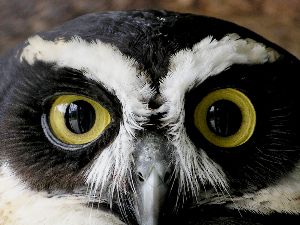
Flounder, Moody Garden Aquarium, Galveston, TX
 Flounder, Moody Garden Aquarium, Galveston, TX |
Ever since I was a child, I've been fascinated by eyes. I doubt that this is very unusual. Sight is the chief sense with which we explore our world. We can't help but notice the eyes of other creatures as well. There are all sorts of sayings about eyes, including "keep an eye out," "look me in the eye," and "eye on the prize." We know that when another being looks at us, and we look at them, there is no room at that moment in the brains of either entity for anything but each other. The eye is often thought of as a center, or focus, as in the eye of a hurricane. Nothing is more startling or intriguing than to look out into the cosmos, with the help of that all-powerful eye, the Hubble Telescope, and find the Eye Nebula staring right back.
 Black Horsefly, Hornsby Bend Waste Treatment Plant, Austin, TX |
 Spectacled Owl, Audubon Zoo, New Orleans, LA |
When, as a little kid, I began drawing, some of my favorite subjects were eyes. Sometimes, I'd start to draw an animal, finish the eye, and never get any farther. I liked eyes so much that I often drew whole series of them, practiced making them look more glass-like and real, and sometimes distorted my creations to have eyes bigger than normal. It is probably no coincidence that I am more of a visual person than aural or tactile. Even as a musician, I rely heavily on my ability to read a printed score in order to create the essentially non-visual art form of music.
One aspect of eyes that appeals to me is that they are often associated with knowledge. "Seeing is believing," "What you can't see won't hurt you," (a mocking assessment of the erroneous assumption that it is better to NOT know things) and "I see" meaning "I understand." A picture cannot be worth a thousand words if it is not seen. People may study their environments to as great a degree as they wish through careful perception. Watching, looking, observing, and seeing are means to an end, which is understanding. While many things may be learned by reading about them, or being told, nothing can substitute for first-hand observation, and that is where our eyes provide us with an invaluable tool: they are our windows to the universe.
| More eyes |